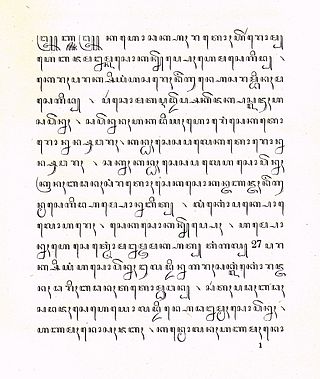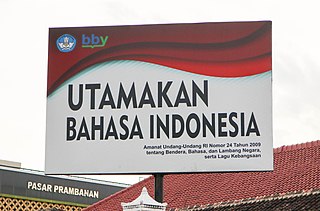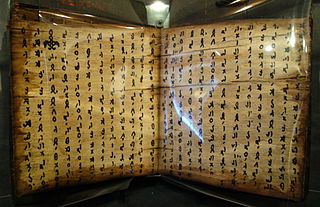Related Research Articles

Malay is an Austronesian language that is an official language of Brunei, Indonesia, Malaysia, and Singapore, and that is also spoken in East Timor and parts of the Philippines and Thailand. Altogether, it is spoken by 290 million people across Maritime Southeast Asia.

Sundanese is a Malayo-Polynesian language spoken by the Sundanese. It has approximately 40 million native speakers in the western third of Java; they represent about 15% of Indonesia's total population.
The Balinese script, natively known as Aksara Bali and Hanacaraka, is an abugida used in the island of Bali, Indonesia, commonly for writing the Austronesian Balinese language, Old Javanese, and the liturgical language Sanskrit. With some modifications, the script is also used to write the Sasak language, used in the neighboring island of Lombok. The script is a descendant of the Brahmi script, and so has many similarities with the modern scripts of South and Southeast Asia. The Balinese script, along with the Javanese script, is considered the most elaborate and ornate among Brahmic scripts of Southeast Asia.

Balinese is a Malayo-Polynesian language spoken by 3.3 million people on the Indonesian island of Bali, as well as Northern Nusa Penida, Western Lombok, Eastern Java, Southern Sumatra, and Sulawesi. Most Balinese speakers also know Indonesian. The Bali Cultural Agency estimated in 2011 that the number of people still using the Balinese language in their daily lives on the Bali Island is under 1 million. The language has been classified as "not endangered" by Glottolog.

Madurese is a language of the Madurese people, native to the Madura Island and Eastern Java, Indonesia; it is also spoken by migrants to other parts of Indonesia, namely the eastern salient of Java, the Masalembu Islands and even some on Kalimantan. It was traditionally written in the Javanese script, but the Latin script and the Pegon script is now more commonly used. The number of speakers, though shrinking, is estimated to be 8–13 million, making it one of the most widely spoken languages in the country. Bawean Madurese, which is a dialect of Madurese, also spoken by Baweanese descendants in Malaysia and Singapore.

Jawi is a writing system used for writing Malay and several other languages of Southeast Asia, such as Acehnese, Banjarese, Kerinci, Maguindanaon, Minangkabau, Tausūg, and Ternate. Jawi is based on the Arabic script, consisting of all of the original 31 Arabic letters, and six additional letters constructed to fit the phonemes native to Malay, and an additional phoneme used in foreign loanwords, but not found in Classical Arabic, which are ca, nga, pa, ga, va, and nya.

Seram is the largest and main island of Maluku province of Indonesia, despite Ambon Island's historical importance. It is located just north of the smaller Ambon Island and a few other adjacent islands, such as Saparua, Haruku, Nusa Laut and the Banda Islands.
The Javanese script is one of Indonesia's traditional scripts developed on the island of Java. The script is primarily used to write the Javanese language, but in the course of its development has also been used to write several other regional languages such as Sundanese, Madurese, and Sasak; the lingua franca of the region, Malay; as well as the historical languages Kawi and Sanskrit. Javanese script was actively used by the Javanese people for writing day-to-day and literary texts from at least the mid-15th century CE until the mid-20th century CE, before its function was gradually supplanted by the Latin alphabet. Today the script is taught in DI Yogyakarta, Central Java, and the East Java Province as part of the local curriculum, but with very limited function in everyday use.

Alfur, Alfurs, Alfuros, Alfures, Aliforoes, Alifuru or Horaforas people is a broad term recorded at the time of the Portuguese seaborne empire to refer all the non-Muslim, non-Christian peoples living in inaccessible areas of the interior in the eastern portion of Maritime Southeast Asia.

More than 700 living languages are spoken in Indonesia. This figure indicates that Indonesia has about 10% of the world's languages, establishing its reputation as the second most linguistically diverse nation in the world after Papua New Guinea. Most languages belong to the Austronesian language family, while there are over 270 Papuan languages spoken in eastern Indonesia. The language most widely spoken as a native language is Javanese.
The Rencong script, locally known as Surat Ulu is a writing system family found in central and south Sumatra, in the regions of Kerinci, Bengkulu, Palembang and Lampung, Indonesia. It was used to write manuscripts in Sumatran languages and Malay, such as the Tanjung Tanah Code of Law. The Malay writing was gradually replaced by the Jawi script, a localized version of the Arabic script.

Mandailing or Mandailing Batak is an Austronesian language spoken in Indonesia, the northern island of Sumatra. It is spoken mainly in Mandailing Natal Regency, North Padang Lawas Regency, Padang Lawas Regency, and eastern parts of Labuhan Batu Regency, North Labuhan Batu Regency, South Labuhan Batu Regency and northwestern parts of Riau Province. It is written using the Latin script but historically used Batak script.

Pegon is a modified Arabic script used to write the Javanese, Sundanese, and Madurese languages, as an alternative to the Latin script or the Javanese script and the old Sundanese script. It was used in a variety of applications, from religion, to diplomacy, to poetry. But today particularly, it is used for religious (Islamic) writing and poetry, particularly in writing commentaries of the Qur'an. Pegon includes letters that are not present in Modern Standard Arabic. Pegon has been studied far less than its Jawi counterpart which is used for Malay, Acehnese and Minangkabau.
Kei is an Austronesian language spoken in a small region of the Moluccas, a province of Indonesia.
Ternate is a language of northern Maluku, eastern Indonesia. It is spoken by the Ternate people, who inhabit the island of Ternate and some other areas of the archipelago, including the western coast of Halmahera, Hiri, Obi, Kayoa, and the Bacan Islands. Historically, it served as the primary language of the Sultanate of Ternate, famous for its role in the spice trade. It has established itself as a lingua franca of the North Maluku province. A North Halmahera language, it is unlike most languages of Indonesia which belong to the Austronesian language family.
Ambelau is an Austronesian language; in 1989, it was spoken by about 5,700 Ambelau people, of whom more than 5,000 lived on the Indonesian island Ambelau and most others in the village Wae Tawa of the nearby island Buru.

Old Sundanese script is a script that developed in West Java in the 14th–18th centuries which was originally used to write Old Sundanese language. The Old Sundanese script is a development of the Pallava script which has reached the stage of modifying its distinctive form as used in lontar texts in the 16th century.

The Lampung or Lampungese are an indigenous ethnic group native to Lampung and some parts of South Sumatra, Bengkulu, as well as in the southwest coast of Banten. They speak the Lampung language, a Lampungic language estimated to have 1.5 million speakers.

Buda Script or (Aksara Buda) or Gunung Script is an archaic script. Based on its shape, the Buda Script still has a close relationship with the Kawi script. This script was previously used on the island of Java and Bali. This type of script is called the Buda script because it is considered to have originated from the pre-Islamic era which is called the Buddhist Age. The word Buda is based on the Buddha word. Manuscripts containing writing using the Buda script are commonly found in mountainous areas. Because of that, this type of script is also called the "Mountain script".
Sundanese numerals is a number system used by Sundanese people and contains a sequence of 10 digits in Sundanese script. The Wilangan writing system is the same as in Arabic numerals, i.e. the writing is directed to the right, only there is a difference in terms of marking, namely that the writing of numbers in Sundanese script must use a pipe sign, because some forms of Sundanese numerals are similar to consonant letters, it is feared that ambiguity will occur.
References
- 1 2 3 Maulana, Ridwan (14 September 2020). "Aksara-aksara di Nusantara: Seri Ensiklopedia" (in Indonesian). Retrieved 30 November 2022.
- ↑ M. Thaha Pattiiha. "Bahasa Tana, Aksara Alifuru, dan Nasib Bahasa Lokal di Maluku". www.academia.edu (in Indonesian). Retrieved 30 November 2022.